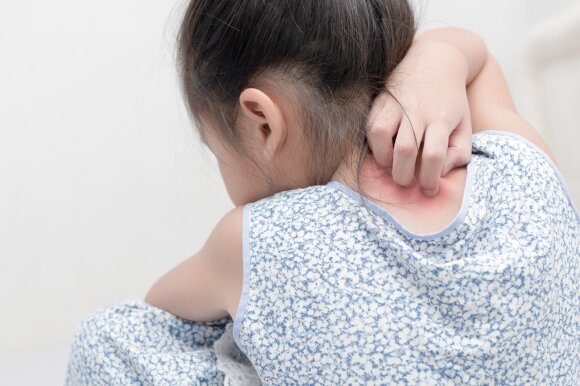
[ad_1]
Atopic dermatitis, or also known as atopic eczema, is a chronic inflammatory skin disease that significantly deteriorates the condition and quality of life of the skin, says Živilė Korsakienė, allergist and clinical immunologist at the Center for Medical Diagnosis and Treatment.
Atopic dermatitis usually affects young children
“The skin that suffers from atopic dermatitis loses moisture much faster, its protective barrier is weakened, therefore, the disease is characterized by dry itchy skin, inflammatory processes develop in the affected areas. The exact causes are unknown. of atopic dermatitis, but scientific evidence suggests that the disease is caused by both genetic, immunological and external factors, “said the allergist in a statement.
According to research, children with allergic parents are at a higher risk of developing atopic eczema. It is estimated that if one of the parents has allergic diseases, this risk increases to 25%, if both, up to 50%. However, even in families of non-allergic parents, 10-15% remain. the risk that the child may develop atopic dermatitis.
According to the doctor, atopic dermatitis usually appears in infancy or early childhood. Up to two out of three people with atopic dermatitis have the disease for up to a year, and four out of five for up to five. It is true that it is noted that with age the disease is reduced and approximately 75 percent. the symptoms of the patients disappear at the age of six years. However, it should be borne in mind that the disease may recur later, if additional adverse factors occur: stress, unhealthy lifestyle, harmful habits. Sometimes atopic dermatitis comes back during puberty. It should be noted that only in rare cases does atopic dermatitis occur for the first time in old age.
The exacerbation of the disease is provoked by various allergens.
According to the allergist, clinical immunologist, atopic dermatitis is complicated by the fact that it is not just a skin disease. Often, in addition to the external symptoms characteristic of this disease – dry skin, itching, redness, peeling, other symptoms such as digestive and defecation disorders occur.

“This disease is also insidious because its exacerbation can be caused by a wide variety of allergens in our daily environment. These can be foods such as dairy products, eggs, wheat and soy products, legumes, fish, nuts, citrus fruits. Also allergens environmental such as house dust mites, pollen, pet hair. Dry skin and exacerbation of lesions are often caused by contact factors, such as washing with alkaline soap, the use of aggressive detergents, even hot or cold, insufficient humidity, ”says Ž. Korsakiene.
Not all rashes are atopic dermatitis.
“It is true that allergic diseases are on the rise. It is estimated that by the year 2050, one in two people in the world will suffer from allergic diseases, and atopic dermatitis is already one of the most common diseases among minors. Therefore It is not surprising that mothers who experience infantile rashes are concerned that it may be atopic dermatitis. However, it should be understood that various rashes do not just occur due to atopic dermatitis.
Allergic rashes can be caused by both food and contact allergens, even inhaled. Some reactions are acute and disappear soon after the stimulus that caused them is removed, others are chronic, last a long time, and the cause is difficult to find. As a result, if you experience an alarming rash or other allergic reaction, it is always recommended to see a doctor, ”says Ž. Korsakiene.
According to the doctor, atopic dermatitis is characterized by dry, scaly and itchy areas on the surface of the skin. However, sometimes, especially when the skin is still damaged by bacteria or fungi, the rash becomes more complicated, signs of infection appear: the so-called “wet” rash, wounds and a yellowish “honey crust”. According to the doctor, in babies under 2 years of age, the rashes usually appear on the cheek area, on the outer surface of the hands and feet, as well as on the hairy part of the head. Atopic eruptions in adults are most common on the flexed surfaces of the hands and feet: elbows, wrists, knees, ankles, hands, neck, and eyelids.

Child allergy
Although atopic dermatitis rashes have certain characteristics, it is not easy to distinguish them from rashes caused by other causes with the naked eye. After evaluating the symptoms of the disease, having collected a history, the doctor may order the additional tests necessary to diagnose the disease and, after identifying the cause of the allergy, select the most appropriate treatment.
Treatment of atopic dermatitis: successful control of the disease.
As with many other allergic diseases, the treatment of atopic dermatitis is the successful management of the disease. After conducting the necessary research to find out which stimuli provoke an exacerbation of the disease, it is possible to control the lifestyle accordingly, so that the exacerbations of allergies are as rare as possible and the manifestation is less acute.
“Once it has been established that the exacerbation of atopic dermatitis is caused by certain foods, it is now possible to review the diet of the food consumed, remove it or avoid allergenic products. Knowing that exacerbations of the disease can be caused, for example, by washing or washing products, go back to choosing mild chemicals that do not contain fragrances, dyes or other harsh ingredients, ”says Ž. Korsakiene.
According to the doctor, the most important thing is proper skin care. In consultation with your doctor, it is recommended to use hygienic measures that do not reduce the function of the skin barrier, to constantly hydrate the skin. Today, there is certainly not a single tool from different manufacturers, each of which can find the most suitable for itself. It is observed that in summer the signs of atopic dermatitis are alleviated, since there is a positive anti-inflammatory effect of ultraviolet rays. However, this in no way means that the sun can be abused.
During periods of exacerbation, the doctor may prescribe anti-inflammatory drugs, usually in the form of a cream or ointment, which are used to apply to the affected areas of the skin. Unfortunately, sometimes infectious dermatitis has to be treated, then other medications are needed. Only in rare cases is systemic treatment required. Consultation with an allergist and clinical immunologist should always be sought regarding treatment, skin care, follow-up, and treatment tactics.
It is strictly forbidden to use the information published by DELFI on other websites, in the media or elsewhere, or to distribute our material in any way without consent, and if consent has been obtained, it is necessary to cite DELFI as the source. .
[ad_2]